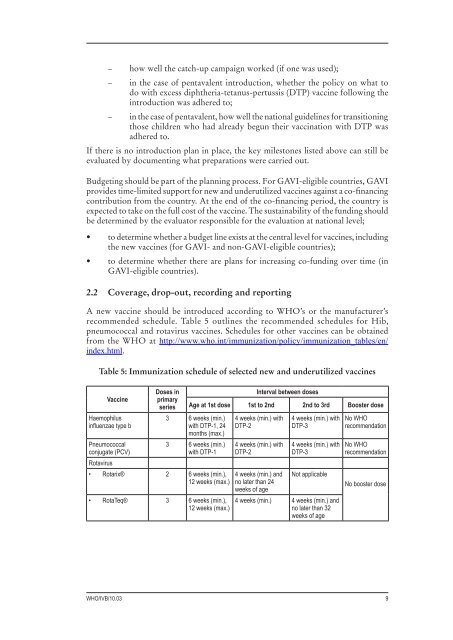New Vaccine Post-Introduction Evaluation - libdoc.who.int - World ...
New Vaccine Post-Introduction Evaluation - libdoc.who.int - World ...
New Vaccine Post-Introduction Evaluation - libdoc.who.int - World ...
Create successful ePaper yourself
Turn your PDF publications into a flip-book with our unique Google optimized e-Paper software.
––<br />
––<br />
––<br />
how well the catch-up campaign worked (if one was used);<br />
in the case of pentavalent <strong>int</strong>roduction, whether the policy on what to<br />
do with excess diphtheria-tetanus-pertussis (DTP) vaccine following the<br />
<strong>int</strong>roduction was adhered to;<br />
in the case of pentavalent, how well the national guidelines for transitioning<br />
those children <strong>who</strong> had already begun their vaccination with DTP was<br />
adhered to.<br />
If there is no <strong>int</strong>roduction plan in place, the key milestones listed above can still be<br />
evaluated by documenting what preparations were carried out.<br />
Budgeting should be part of the planning process. For GAVI-eligible countries, GAVI<br />
provides time-limited support for new and underutilized vaccines against a co-financing<br />
contribution from the country. At the end of the co-financing period, the country is<br />
expected to take on the full cost of the vaccine. The sustainability of the funding should<br />
be determined by the evaluator responsible for the evaluation at national level;<br />
•<br />
•<br />
to determine whether a budget line exists at the central level for vaccines, including<br />
the new vaccines (for GAVI- and non-GAVI-eligible countries);<br />
to determine whether there are plans for increasing co-funding over time (in<br />
GAVI-eligible countries).<br />
2.2 Coverage, drop-out, recording and reporting<br />
A new vaccine should be <strong>int</strong>roduced according to WHO’s or the manufacturer’s<br />
recommended schedule. Table 5 outlines the recommended schedules for Hib,<br />
pneumococcal and rotavirus vaccines. Schedules for other vaccines can be obtained<br />
from the WHO at http://www.<strong>who</strong>.<strong>int</strong>/immunization/policy/immunization_tables/en/<br />
index.html.<br />
Table 5: Immunization schedule of selected new and underutilized vaccines<br />
<strong>Vaccine</strong><br />
Haemophilus<br />
influenzae type b<br />
Pneumococcal<br />
conjugate (PCV)<br />
Rotavirus<br />
Doses in<br />
primary<br />
series<br />
Interval between doses<br />
Age at 1st dose 1st to 2nd 2nd to 3rd Booster dose<br />
3 6 weeks (min.)<br />
with DTP-1, 24<br />
months (max.)<br />
3 6 weeks (min.)<br />
with DTP-1<br />
• Rotarix®<br />
2 6 weeks (min.),<br />
12 weeks (max.)<br />
• RotaTeq®<br />
3 6 weeks (min.),<br />
12 weeks (max.)<br />
4 weeks (min.) with<br />
DTP-2<br />
4 weeks (min.) with<br />
DTP-2<br />
4 weeks (min.) and<br />
no later than 24<br />
weeks of age<br />
4 weeks (min.) with<br />
DTP-3<br />
4 weeks (min.) with<br />
DTP-3<br />
Not applicable<br />
4 weeks (min.) 4 weeks (min.) and<br />
no later than 32<br />
weeks of age<br />
No WHO<br />
recommendation<br />
No WHO<br />
recommendation<br />
No booster dose<br />
WHO/IVB/10.03<br />
9

















